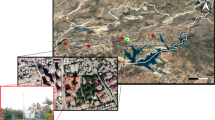Abstract
Many studies reported the coexisting trends of decreasing and increasing pan evaporation in some large scale regions. This study proved that the coexisting trends also occurred in small scale region as well as in large scale region. To discover the important factors governing the incompatible trends of annual pan evaporation, annual climatic data of ten meteorological stations at the Liaohe Delta over recent 45 years were analyzed by the partial correlation analysis, and the results showed the strongest statistically correlation between annual relative humidity and annual pan evaporation. Researches on two extreme cases suggested there was obvious contrary trend between annual relative humidity and annual pan evaporation for one case, in despite of slight contrary trend for another case. Generally, annual relative humidity most likely was an important factor relating to the trend of annual pan evaporation. At the same time, an expanded urbanization and irrigation were seen around these meteorological stations. Urbanization and irrigation exerted opposite effects on pan evaporation, they therefore were speculated to be the ultimately inducements causing unbalanced relative humidity, and led to incompatible pan evaporation.
Similar content being viewed by others
References
Alvarez VM, Gonzalez MM, Baille A, Molina JM (2007) A novel approach for estimating the pan coefficient of irrigation water reservoirs Application to South Eastern Spain. Agric Water Manag 92:29–40
Brutsaert W, Parlange MB (1998) Hydrologic cycle explains the evaporation paradox. Nature 396:30
Chattopadhyay N, Hulme M (1997) Evaporation and potential evapotranspiration in India under conditions of recent and future climate change. Agric For Meteorol 87:55–73
Chen D, Gao G, Xu CY, Guo J, Ren G (2005) Comparison of the Thornthwaite method and pan data with the standard Penman-Monteith estimates of reference evapotranspiration in China. Clim Res 28:123–132
Cohen S, Ianetz A, Stanhill G (2002) Evaporative climate changes at Bet Dagan, Israel, 1964–1998. Agric For Meteorol 111:83–91
Fu GB, Charles SP, Yu JJ (2009) A critical overview of pan evaporation trends over the last 50 years. Clim Change 97:193–214
Governmental chorography office of Panjin city (1998) Panjin City Chorography (agriculture volume), 1st ed. Chorography, Beijing
Hobbins MT, Ramírez JA, Brown TC (2004) Trends in pan evaporation and actual evapotranspiration across the conterminous U.S.: paradoxical or complementary? Geophys Res Lett 31:L13503. doi:10.1029/2004GL019846
Jovanovic B, Jones DA, Collins D (2008) A high-quality monthly pan evaporation dataset for Australia. Clim Change 87:517–535
Kirono DGC, Jones RN, Cleugh HA (2009) Pan-evaporation measurements and Morton-point potential evaporation estimates in Australia: are their trends the same? Int J Climatol 29:711–718
Lawrimore JH, Peterson TC (2000) Pan evaporation trends in dry and humid regions of the United States. J Hydrometeorol 1:543–546
Liaoning Bureau of Statistics (1993–2006) Statistical Yearbook of Liaoning. China Statistics Press, Beijing
Linacre ET (2004) Evaporation trends. Theor Appl Climatol 79:11–21
Liu BH, Xu M, Henderson M, Gong W (2004) A spatial analysis of pan evaporation trends in China, 1995–2000. J Geophys Res 109:D15102. doi:10.1029/2004JD004511
Liu B, Ma ZG, Xu JJ, Xiao ZN (2009) Comparison of pan evaporation and actual evaporation estimated by land surface model in Xinjiang from 1960 to 2005. J Geogr Sci 19:502–512
Lowe LD, Webb JA, Nathan RJ, Etchells T, Malano HM (2009) Evaporation from water supply reservoirs: an assessment of uncertainty. J Hydrol 376:261–274
Peterson TC, Golubev VS, Grolsman PY (1995) Evaporation losing its strength. Nature 377:687–688
Qian Y, Kaiser DP, Leung LR, Xu M (2006) More frequent cloud-free sky and less surface solar radiation in China from 1955 to 2000. Geophys Res Lett 33:1–4
Rayner DP (2007) Wind run changes: the dominant factor affecting pan evaporation trends in Australia. J Clim 20:3379–3394
Roderick ML, Farquhar GD (2002) The cause of decreased pan evaporation over the past 50 years. Science 298:1410–1411
Roderick ML, Farquhar GD (2004) Changes in Australian pan evaporation from 1970 to 2002. Int J Climatol 24:1077–1090
Roderick ML, Farquhar GD (2005) Changes in New Zealand pan evaporation since the 1970s. Int J Climatol 25:2031–2039
Taichi T, Junichi Y, Chanchai S (2005) Time-space trend analysis in pan evaporation over Kingdom of Thailand. J Hydrol Eng 10:205–215.
Vicente P, Rodrigues S (2004) On climate variability in Northeast of Brazil. J Arid Environ 58:575–596
Wang ZY, Liu ZX, Zhang ZX, Liu XB (2009) Subsurface drip irrigation scheduling for cucumber (Cucumis sativus L.) grown in solar greenhouse based on 20 cm standard pan evaporation in Northeast China. Sci Hortic 123:51–57
Xu M, Chang CP, Fu CB, Qi Y, Robock A, Robinson D, Zhang HM (2006) Steady decline of East Asian monsoon winds, 1969–2000: evidence from direct ground measurements of wind speed. J Geophys Res 111:D24111. doi:10.1029/2006JD007337
Xu ZX, Li JY, Liu CM (2007) Long-term trend analysis for major climate variables in the Yellow River basin. Hydrol Process 21:1935–1948
Zhang YQ, Liu CM, Tang YH, Yang YH (2007) Trends in pan evaporation and reference and actual evapotranspiration across the Tibetan Plateau. J Geophys Res 112:1–12
Zhao CY, Ren GY, Zhang YF, Wang Y (2009) Climate change of the Northeast China over the past 50 years. Journal of Arid Land Resources and Environment 23:25–31
Zuo HC, Li DL, Hu YQ, Bao Y, Lv SH (2005) Characteristics of climatic trends and correlation between pan-evaporation and environmental factors in the last 40 years over China. Chin Sci Bull 50:1235–1241
Author information
Authors and Affiliations
Corresponding author
Rights and permissions
About this article
Cite this article
Ji, Y., Zhou, G. Important factors governing the incompatible trends of annual pan evaporation: evidence from a small scale region. Climatic Change 106, 303–314 (2011). https://doi.org/10.1007/s10584-010-9900-z
Received:
Accepted:
Published:
Issue Date:
DOI: https://doi.org/10.1007/s10584-010-9900-z




